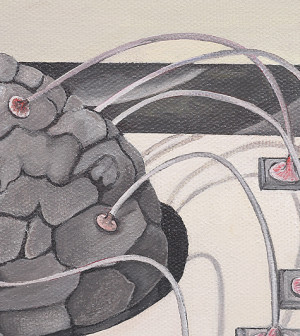- Navigating Your Midlife Crisis: Embracing New Possibilities
- City Raccoons Showing Signs of Domestication
- Mapping the Exposome: Science Broadens Focus to Environmental Disease Triggers
- One Week Less on Social Media Linked to Better Mental Health
- Your Brain Changes in Stages as You Age, Study Finds
- Some Suicide Victims Show No Typical Warning Signs, Study Finds
- ByHeart Formula Faces Lawsuits After Babies Sickened With Botulism
- Switch to Vegan Diet Could Cut Your Greenhouse Gas Emissions in Half
- Regular Bedtime Does Wonders for Blood Pressure
- Dining Alone Could Mean Worse Nutrition for Seniors
New Electrical Stimulation Therapy Can Help Stroke Patients Move Paralyzed Hand

A new form of electrical stimulation therapy can help rewire the brain and restore some dexterity to a hand that’s been paralyzed by stroke, a new clinical trial shows.
In the experimental therapy, patients use their good hand to help their brain regain control over the paralyzed hand, explained lead researcher Jayme Knutson, an assistant professor of physical medicine and rehabilitation at Case Western Reserve University School of Medicine in Cleveland.
A sensor-laden glove worn on the patient’s good hand sends signals to electric stimulators attached to the paralyzed hand, prompting the muscles in the inert hand to mirror the movements of the functioning hand, Knutson said.
During physical therapy patients think about opening both hands at the same time, as the electrical stimulation forces the paralyzed hand to reflect the movements of the good hand.
“We think we’re training the brain,” Knutson said. “The stimulation coincides with the patients’ attempt to open their hand. That sort of puts the brain back in control, in a roundabout way. The brain is active in attempting to open the hand.”
Electrical stimulation already has been in use as a therapy to help restore movement in a paralyzed hand, but up until now the stimulator has automatically opened and closed the hand at several-second intervals without any input from the patient, Knutson said.
Knutson and his colleagues tested their new approach in a clinical trial involving 80 stroke survivors.
For 12 weeks, half the survivors received electrical stimulation therapy using the new “mirroring” therapy. The other half also used an electrical stimulator, but in standard therapy that mechanically opened and closed the inert hand with no input from the brain.
Both groups used their assigned electrical stimulator on their own at home for 10 hours a week. They also spent three hours a week practicing hand tasks with an occupational therapist in the lab.
Prior to and six months following therapy, all patients were given a standard dexterity test that measured the number of blocks they could pick up, lift over a barrier and release in another area on a table within a 60-second period.
Patients who received the new therapy experienced markedly better improvement than those in the control group. There were able to move an average of 4.6 blocks more than they had prior to therapy, compared with an improvement of 1.8 blocks for those who received standard therapy.
Improvement was greatest for people who received the new therapy less than two years following their stroke, the researchers reported. These patients experienced an improvement of 9.6 blocks on the dexterity test, compared to a 4.1-block improvement in the standard therapy group.
“It’s common to see the earlier you receive therapy after a stroke, the better able the brain is to recover,” Knutson said. If people delay therapy, the brain learns compensatory “bad habits” that become ingrained and are difficult to reverse, he said.
By the end of the treatment, 97 percent of patients who received the new therapy felt they could use their hand better than at the start of the study, researchers report.
Placing the brain somewhat in charge appears to “work on the wiring” of the nervous system, said Daniel Lackland, a professor of translational neuroscience at the Medical University of South Carolina in Charleston.
“This electrical stimulation is supplementing the body’s electrical system at the source of where you want the action to be,” Lackland said. “You’re building up that system. You’re enhancing the electrical system that’s already there.”
Both Knutson and Lackland said larger follow-up trials are needed before the technology can be submitted for U.S. Food and Drug Administration approval. Those trials are in the works, but it will likely be years before the therapy is widely available, Knutson said.
“You don’t want to give people false hope,” said Lackland, a spokesman for the American Stroke Association. “We’re not quite ready. But it is heading in a direction where there’s a therapy that’s relatively easy to use, and it’s going to be helpful for the appropriate type of person.”
The findings were published in the October issue of Stroke.
More information
For more on post-stroke rehabilitation, visit the U.S. National Institutes of Health.
Source: HealthDay
Copyright © 2025 HealthDay. All rights reserved.










